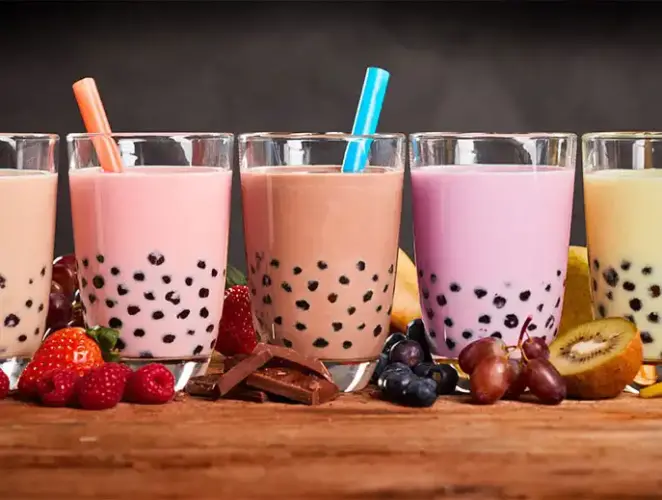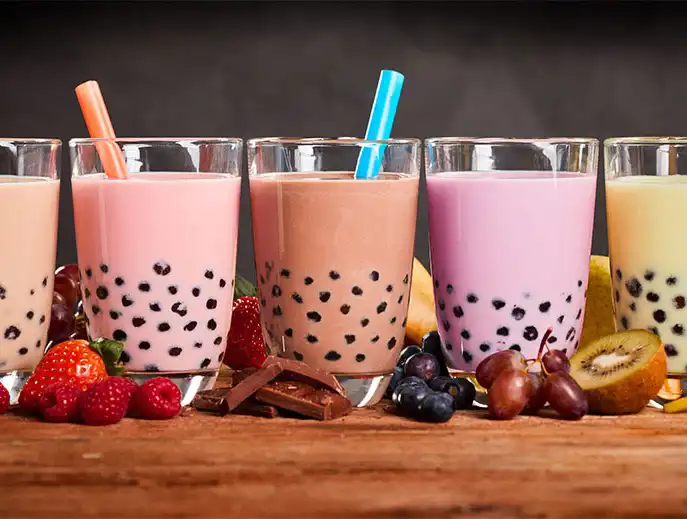Last Updated on March 28, 2025

In essence, boba tea is a beverage featuring tapioca or fruit-flavored pearls. However, there’s much more to it than meets the eye. When someone mentions ‘Boba tea,’ they’re referring to a traditionally cold-served drink that combines a tea base with milk or fruit flavor, adorned with edible pearls (the ‘boba’ in boba tea) nestled inside a cup.
Boba tea is known by various names, which can sometimes befuddle people. You might have come across some of these terms, but rest assured, they all signify the same delectable drink: bubble tea, pearl tea, bubble milk tea, boba, boba fruit tea, or tapioca tea.
Over the past few years, Boba Tea has seen a surge in popularity, thanks in large part to the novel experience of enjoying tasty edible pearls in a beverage.
Tapioca Boba
Traditional milk boba tea features tapioca balls, made from starch, often lovingly referred to as ‘pearls.’ This concoction typically includes milk, water, tea, and sugar, with plenty of room for variations. Boba tea is available in both hot and cold iterations, typically served in a wide-mouth plastic cup sealed with clear plastic wrap. Traditional boba pearls rest at the cup’s bottom, offering a satisfying chewy texture. They can be likened to a cross between chewing gum and jell-o, minus the gelatin, and can be enjoyed at any time of day. While most tapioca pearls are black, some variants come in white or even transparent.
Popping Boba
Fruit-based boba often pairs with a variety of toppings, but popping boba is a popular choice. Popping boba consists of edible, often fruit-filled spheres enclosed in a gel-like skin. As the name implies, they burst with flavor when squeezed and are typically crafted from seaweed extract, calcium compounds, fruit juice, water, and sweeteners.
Jelly Topping
Another common topping choice is jelly, chewy rectangular fruit-flavored bits resembling jell-o. Surprisingly, these toppings don’t contain gelatin but are crafted from either Konjar, a vegetable by-product, or coconut meat. Beyond their delightful taste, jellies are favored for being cholesterol-free and high in fiber.
Who Invented Boba Tea?
In a nutshell, two distinct teahouse workers in Taiwan during the 1980s pioneered boba tea.
The First Origin Story
One narrative traces bubble tea’s roots back to the 1980s in Taichung, Taiwan. Ms. Lin Hsi Hui innovatively added tapioca balls to her iced tea, initially removed from a Taiwanese dessert. Her employer, Mr. Liu Han-Chieh, the owner of a tea room, had just started serving iced tea following a trip to Japan, with no intention of altering the traditional recipe. However, Lin Hsi Hui’s co-workers recognized the uniqueness of her iced tea with tapioca balls and it instantly became a hit. Recognizing its popularity, owner Han-Chieh added the drink to the tearoom’s menu, eventually making it the most frequently ordered beverage.
The Second Origin Story
The other account attributes the creation of bubble tea to Tu Tsong-he, a teahouse owner in Tainan, Taiwan. Inspired by tapioca balls he spotted in the market, he began adding them to his tea. He dubbed it “pearl tea” due to the resemblance of the boba to precious gems in black tea. He added honey and brown sugar to sweeten the tea and offered black tapioca as an option. While it’s unclear which of these two inventors first conceived bubble tea, their accidental experiments birthed a revolutionary concept. Today, Taiwan boasts hundreds of boba tea shops, and the bubble tea industry has expanded with diverse tea flavors and add-ons like pudding, popping boba, and jelly. By 2019, the boba industry had reached a value of $2.4 billion and is projected to grow by another $2 billion in the next seven years.
The popularity of boba tea has led to innovative products like wider straws due to the tapioca pearls’ size, and the rise of reusable metal straws to cater to avid boba enthusiasts. The evolution of boba tea continues to intrigue and excite.
Why is Boba So Popular?
1. Unique Taste and Edible Experience: Boba tea offers a drinking experience like no other. When you pierce a wide straw through the plastic covering of the cup, you’re in for a surprise. Depending on the flavor and topping, you’ll sip tea while chewy or bursting pearls enter your mouth, creating a delightful sensation.
2. Wide Variety of Flavors and Toppings: Boba tea can be served with a milk or fruit base, and the flavors are incredibly diverse, often unique and distinct from other beverages. From original milk and matcha to taro and exotic choices like passion fruit and lychee, boba teas are a flavor adventure. The assortment of toppings, including boba, popping boba, jelly, red bean, and pudding, adds to the excitement.
3. Aesthetic Appeal for Social Media Sharing: Boba tea’s distinctive appearance makes it a favorite for social media sharing. With numerous boba tea varieties and customization options, people love to showcase their unique boba tea creations on platforms like Instagram, Facebook, and Snapchat.
Is Boba Tea Unhealthy?
In summary, whether boba tea is healthy or not depends on your choice of boba. Traditional bubble tea, contrary to some beliefs, is not a health drink. It typically contains significant amounts of sugar, calories, and fat, often akin to or exceeding the levels found in soda. Milk bubble tea, in particular, can be high in sugar.
While tea is generally considered a healthy beverage due to its antioxidants and potential health benefits, boba milk tea is often regarded as a “guilty treat” or dessert due to its sugar content. Fruit boba teas often feature syrups loaded with artificial sweeteners and other less healthy ingredients to enhance the taste. Tapioca pearls themselves are calorie-rich due to their starch content (approximately 100 calories per cup).
Is Boba Vegan?
In brief, boba is mostly vegan-friendly, but it’s essential to inquire about specific components. The typical boba in milk boba tea, made from tapioca, doesn’t contain gelatin, making it suitable for a vegan diet. Popping pearls in fruit boba are typically vegan, with seaweed extract and calcium compounds used, sans gelatin. The fruit flavor, usually derived from puree or syrup, is typically vegan.
However, the milk component is where vegan-friendliness can vary. Many boba shops offer vegan milk alternatives like oat milk, almond milk, or nut milk. But it’s crucial to check with the staff, as some shops may use cow’s milk. Thankfully, most boba shops provide vegan-friendly milk options, ensuring vegans can enjoy the boba experience without dietary concerns.
Where Did Tapioca (the ‘Boba’ in Boba Tea) Originate?
The history of boba tea is intricate, but the origins of tapioca are more straightforward. Tapioca is the primary ingredient in traditional milk-based boba tea
, extracted from cassava roots. Cassava plants are indigenous to the Americas but are now grown in tropical regions worldwide, including Africa, South America, and Southeast Asia.
The first recorded use of tapioca was in Europe in 1544, introduced by the Portuguese, who brought cassava to Africa, where it was cultivated and used for making flour. This flour was then exported to Asia, where it was used to create tapioca pudding. Tapioca pudding was a delicacy in South and Southeast Asia for centuries. In the 19th century, starch-based puddings, including tapioca, gained popularity in Europe and North America. The most famous starch-based pudding was English sago pudding, made from sago, a similar but distinct starch native to Asia. While the exact year when tapioca pearls were first created remains uncertain, it is known that they were invented in the Southeast Asian islands, including Brunei, Indonesia, Malaysia, the Philippines, Singapore, and East Timor. These pearls were commonly used in various dishes to enhance texture and taste, eventually making their way to Taiwan, where they were introduced in milk tea to create boba tea.
How Is the ‘Boba’ in Boba Tea Made?
Tapioca balls, also known as boba, are derived from the cassava plant. The process of crafting tapioca balls involves cutting cassava roots into small pieces and boiling them until they become soft and their juice can be extracted. This juice is then used to create tapioca balls, which are sun-dried and packaged. To achieve different shapes, various tools are employed. For instance, flower shapes are formed with a flower cutter, and cubes are created using a cube cutter. Once shaped, the tapioca balls are stored in a refrigerator for at least two days before being used in a beverage.
How to Make Boba at Home
Now that you’ve delved into the world of boba tea, let’s explore how to make it in the comfort of your own home. To start, gather your supplies. Depending on your preferred topping, you may select tapioca pearls, which can be easily found on platforms like Amazon and Walmart. Additionally, you’ll need your desired tea, milk (or fruit pulp for fruit-based boba), brown sugar, and a few simple steps:
1. Combine water and your chosen tea in a medium-sized pot and heat on high. Bring the mixture to a boil, then remove it from the heat and let the tea cool to room temperature.
2. In another medium-sized pot, boil water until it reaches a rolling boil. Add the tapioca pearls and boil them for 15-20 minutes until they become soft. Check periodically after the first 10 minutes.
3. Drain the tapioca pearls using a strainer.
4. Place the strained tapioca pearls in a bowl. Add brown sugar to the strainer and pour hot water over it.
5. Stir the tapioca pearls until the brown sugar dissolves. Allow the pearls to soak in the brown sugar syrup for 30 minutes, then set them aside.
6. When ready to serve, place the tapioca pearls (and ice if desired) in glasses. Add the brown sugar syrup, tea, and milk to taste. Stir well, insert a straw, and enjoy!
Where to Buy Bubble Tea
To find boba tea, the simplest approach is to search online for “boba shops near me.” Most boba tea is prepared fresh and sold at specialized boba shops, which can be mom-and-pop stores or franchises. Besides boba shops, many Asian restaurants and grocery stores also offer boba tea, either freshly prepared or available in cans. Boba tea enjoys widespread popularity in various states across the United States, with California having the highest concentration of boba tea stores. Innovations in boba tea have also given rise to options like goba tea, offering a healthy bottled boba tea available for online purchase. A quick Google search for “boba to-go” will yield various portable boba tea choices.
Conclusion
Invented in the 1980s and steadily gaining popularity, boba tea has proven to be more than just a passing fad. Its appeal continues to grow, with an expected annual growth rate of nearly 8% over the next seven years. These milk and fruit-based teas have created a distinct beverage category, introducing a novel and unparalleled drinking experience.
While the majority of boba enthusiasts fall within the 18-35 age group, boba tea transcends age boundaries, appealing to young children and grandparents alike. The world’s fascination with the chewy or bursting experience found in boba tea shows no signs of waning.
As fervent boba fans ourselves, we believe that boba tea has not yet reached its full potential and continues to captivate new audiences. We look forward to seeing you share your boba adventures on social media in the future!
- 20 Affordable Meal Prep Companies and Food Subscriptions Boxes for Busy Families
- 3 Amazing Low-Calorie Meal Preparation Ideas For Busy Moms
- 4 Absolute Mouthwatering Fruit Charcuterie Board Ideas
- 4 Dinner Party Games For Adults For Your NYE Party (Plus Dinner Ideas!)
- 5 Amazing Holiday Cocktail Menu for Cozy Nights With Close Friends
- 5 Delicious, Guilt-Free Super Bowl Desserts You Can Easily Make
- 5 Effective Ways To Get The Most Out Of Your Protein Shakes
- 5 Practical Ways to Stop Sugar Cravings
- 6 High Protein Vegetable Smoothie Recipes Your Taste Buds Will Love
- 6 Mouth-Watering Superfood Recipes That Are Easy to Make
- 6 Restaurants With Great Cocktails in Orlando
- 7 New Years Eve Drinks and Cocktails Menu to Cheer The Year
- 8 Tips to Get Great Intermittent Fasting Results
- Christmas Dinner For Two: The Perfect Food For a Cozy Night
- Christmas Dinner Ideas: Elevate Your 2024 Holiday Feast with Delicious Inspiration
- Clean Eating Breakfast Ideas to Help Start Your Day
- Creating the Ultimate Cinco de Mayo Menu in 7 dishes
- Do Artificial Sweeteners Break A Fast?
- Exploring the World of Tea: A Comprehensive Guide to All Types of Tea
- Favorite Comfort Foods: Indulge in Timeless Classics
- Food Garden: 5 Ways You Can Start Your Own At Home
- How to Build the Perfect Spooky Graveyard Terrarium [DIY Tutorial]
- How to Cook Asparagus in 5 Simple and Tasty Ways
- How to Stop Eating When Bored: Tips, Snack Ideas, and More
- Ideal Coffee Shop with Outdoor Seating: Discover 12 Unmissable Listings
- Most popular and delicious Mexican dishes
- Review: Crumbl Cookies in Winter Park + Our 3 Favorite Irresistible Flavors!
- StoneFruit Coffee Co. is a Coffee Lovers Dream 2021
- Thanksgiving Party Guide: 5 Steps For an Awesome Friendsgiving Dinner
- The Benefits of Organic Turmeric and Turmeric Supplements
- The Ultimate Girls Night in Checklist: 6 Games, Playlists, and Drinks
- Upscale Drinks: 7 Amazing Cocktails You Can Make at Home
- What Should I Eat for Dinner and When? A Dietitian’s Opinion 2024
- Which Green Juice Powder Is Better? Organifi vs Amazing Grass 2024 [REVIEW]
- The Tamarind Benefits: Exploring its Rich History, Flavor, and Health Advantages | 2024
Meet Kourtney, a writer specializing in sex and relationships. Known for her honest and insightful approach, she explores themes of intimacy and personal growth. Her work combines personal anecdotes, expert opinions, and practical advice, helping readers navigate the complexities of modern relationships and embrace their desires. Kourtney's writing serves as a guide for those seeking authentic and fulfilling connections.
- This author does not have any more posts.


